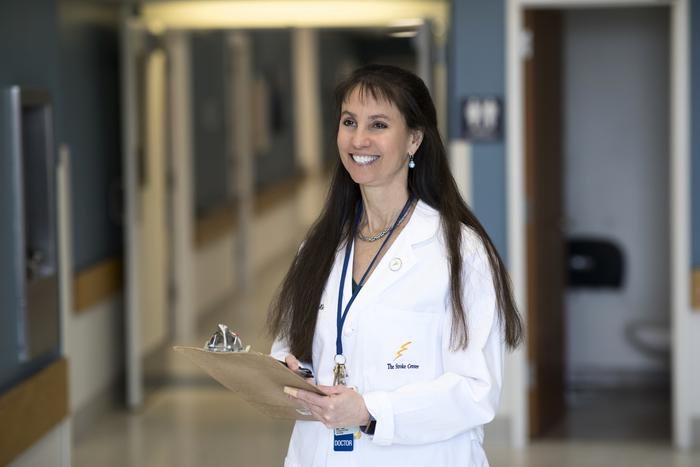An ambitious, nationwide clinical trial led by UVA Health’s Karen Johnston, MD, has provided doctors with long-needed insights into the importance of managing stroke patients’ blood sugar after treatment with clot-busting therapy. The findings will help improve stroke care and save lives.

Credit: Dan Addison | UVA Communications
An ambitious, nationwide clinical trial led by UVA Health’s Karen Johnston, MD, has provided doctors with long-needed insights into the importance of managing stroke patients’ blood sugar after treatment with clot-busting therapy. The findings will help improve stroke care and save lives.
The SHINE trial, funded by the National Institutes of Health’s National Institute of Neurological Disorders and Stroke (grant U01 NS069498), was conducted at UVA Health and 69 other hospitals around the country. The new analysis of the trial results, led by UVA Health’s Andrew Southerland, MD, found that high blood sugar shortly after thrombolysis – opening blocked arteries in the brain with a clot-busting drug – was associated with greater risk for potentially deadly brain bleeds, particularly in older patients with more severe strokes. These brain bleeds, known as symptomatic intracerebral hemorrhages, are considered one of the most dangerous complications of ischemic stroke treatment.
The trial results also suggested that intensive efforts to normalize blood sugar by aggressively administering insulin after thrombolysis was not associated with reduced risk for one of these brain bleeds. However, the researchers say that more research is needed before they could rule out the potential benefit of early insulin administration, as it may help with a “cascade of tissue injury” that can trigger an intracerebral hemorrhage.
“This is the first large-scale prospective clinical trial in stroke patients to provide data on the post-treatment effects of high blood sugar on the risk of symptomatic intracerebral hemorrhage with thrombolysis,” said Southerland, a stroke expert at UVA Health and the UVA School of Medicine. “These data suggest that more focus and research is needed on the management of high blood sugar in the treatment of stroke patients, particularly those with higher risk, more severe strokes.”
About the SHINE Trial
The Stroke Hyperglycemia Insulin Network Effort (SHINE) trial was sponsored by the National Institutes of Health and led nationally by Johnston and the UVA stroke research team. Of the 1,151 SHINE trial participants, 725, or 63%, underwent thrombolysis. Slightly more than half were men, and the median age was 65. Approximately 80% had type 2 diabetes.
Of these patients, 372 were randomly assigned to receive intensive insulin treatment, while 353 received the standard sliding scale treatment. After adjusting for variables that could influence the results, the researchers found that the intensive insulin treatment regimen used in the trial did not appear to make a difference in the risk for intracerebral hemorrhage.
They did find, however, that in the first 12 hours after thrombolysis, every 10 mg/dL increase in median blood sugar increased the odds of intracerebral hemorrhage by 8%. In addition, how long it took patients to achieve a normal blood sugar also appeared to make a difference – patients who reached a lower blood sugar (less than or equal to 180 mg/dL) sooner typically fared better.
In general, high blood sugar after thrombolysis was associated with a greater risk for a brain bleed and with poor outcomes overall, particularly in the early post-treatment period, the researchers report.
“One of the most important things patients can do to decrease their risk of stroke, particularly among diabetics, is work with their doctors and lifestyle to manage their blood sugar,” said Southerland, of UVA’s Department of Neurology. “The SHINE trial suggests that we as providers need to have a similar concern for high blood sugar after stroke treatment as we do already with other risk factors, such as high blood pressure.”
Southerland and his colleagues say that additional research is warranted to better understand how best to manage patients’ blood sugar after thrombolysis, particularly for patients who suffer more severe strokes. That research, they say, could improve outcomes and reduce the risk of intracerebral hemorrhages.
“We hope that these results will help inform future clinical trials looking at the treatment of blood sugar in higher risk patients with more severe strokes, particularly those undergoing clot removal procedures,” Southerland said. “It is exciting to be able to lead this research here at UVA, where we can work to improve stroke outcomes for our patients locally while helping move the field forward worldwide.”
Johnston, the SHINE trial leader, was pleased to see the new insights into best practices for stroke care. “These data from the SHINE trial continue to inform the national stroke community about potential approaches to treating hyperglycemic stroke patients to assure better outcomes,” she said. “With more and more patients now getting lifesaving acute stroke interventions, Dr. Southerland’s discovery suggests that this patient population warrants further study to determine the risks and benefits of glucose control. This work aligns beautifully with the new UVA Precision Health for Populations effort.”
Findings Published
The researchers have published their findings in the scientific journal Neurology. The paper’s authors were Southerland, Stephan A. Mayer, Nicole A. Chiota-McCollum, Ashley C. Bolte, Qi Pauls, L. Creed Pettigrew, Thomas P. Bleck, Mark R. Conaway and Johnston.
To keep up with the latest medical research news from UVA, subscribe to the Making of Medicine blog.



